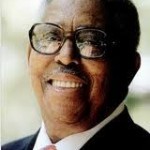Exploding Myths About ‘Black Power, Jewish Politics’
Photo: From left Bishop James Shannon, Rabbi Abraham Heschel, Dr. Martin Luther King and Rabbi Maurice Eisendrath. Tomb of the Unknown Soldier, Arlington Cemetery, February 6, 1968. (Charles Del Vecchio/Washington Post/Getty Images
(Texas Public Radio) Many Americans tell the story of Black-Jewish political relations like this: First, there was the Civil Rights movement, where the two groups got along great.
This was the mid-1950s to the mid-60s — picture Rabbi Abraham Joshua Heschel and Rev. Martin Luther King Jr. marching arm-in-arm from Selma to Montgomery. And James Chaney, Andrew Goodman and Michael Schwerner, murdered while organizing to register black voters in Mississippi.
Then, the story goes, there was a shift. In the mid-’60s, with the rise of black nationalism (and what some describe as black anti-Semitism), “the once wonderful alliance dissolved and split. And since the mid 1960s, it’s been terrible.”
That, says historian Marc Dollinger, is “the accepted wisdom on how to understand Jewish participation in the civil rights movement.”
Except, Dollinger adds, that’s not really what happened. (more)
White politicians were coercing African-Americans to vote long before civil rights
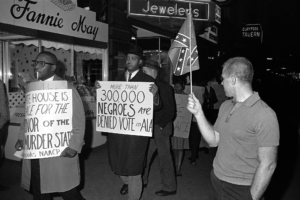
Civil Rights advocates protesting against discriminatory voting laws in 1964 (AP Photo/ Bob Daugherty)
(The Conversation) During a recent campaign rally in Tennessee, Donald Trump claimed that most African-Americans have been voting for the Democratic Party for over a century. He told supporters, “African-Americans vote for Democrats, for the most part. Vast majority. They’ve been doing it for over a hundred years.”
A number of commentators have pointed out that Trump’s comment is historically inaccurate because most African-Americans in the south could not vote until the Voting Rights Act was passed in 1965. Additionally, many African-Americans who could vote before the 1960s – located mostly in the north – were supporters of the Republican Party, the party of Lincoln and emancipation. This was especially true before Franklin Roosevelt introduced the New Deal during the Great Depression, but well into the 1960s moderate-to-liberal Republican candidates still won sizeable shares of the black vote.
Yet while Trump’s statement was clearly ignorant, he did accidentally stumble into an overlooked part of American history. (more)
Opinion: Memorializing African-American lynching victims is past due, and it must be only a start
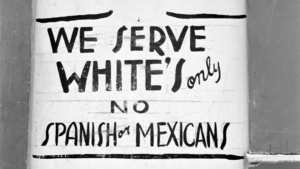
Sign is a vestige of “Juan Crow” laws in Texas, which followed a decade of violence, including lynchings, against Mexicans in the state. (Russell Lee Photography Collection The Dolph Briscoe Center for American History/University of Texas at Austin)
(Washington Post) The National Memorial for Peace and Justice, which recently opened in Montgomery, Alabama, forces America to reckon with the lynching of more than 4,000 African Americans. But this should only be the beginning of the historical reckoning.
Over the past two centuries, racial violence has also targeted Native Americans, Mexicans and Chinese. Recognizing other histories of racial violence will not detract from the memorial’s urgent work. Rather it will help us to better understand what it is that we must mourn. The mass lynching of African Americans was more than a tragic national mistake: It was central to how a nation built on racial violence and white supremacy functioned. (more)
For the First Time, See Historically Excluded Black Folk Artists at the Met
‘History Refused to Die’ shows off the masterful works made by self-taught artists from the American South
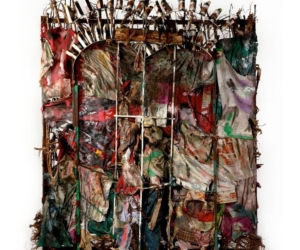
Thornton Dial, “History Refused to Die” (2004) (The Metropolitan Museum of Art, New York, Gift of Souls Grown Deep Foundation from the William S. Arnett Collection, 2014)
(Smithsonian) WNYC’s art critic Deborah Solomon predicts that many of the artists featured in a recently opened show at the Metropolitan Museum of Art will soon become household names.
It’s a high bar, but one that History Refused to Die excites. The exhibition highlights 30 works by self-taught black artists from the American South. This is the first time the Met has exhibited works by these historically excluded artists. By presenting their sculptures, paintings, quilts and other artistic works alongside the Met’s 20th-century collection, the artists—considered Outsider artists for their nontraditional approaches or mediums—are finally being given the recognition they deserve.
The show, originated by former Met curator Marla Prather and organized by Randall R. Griffey, curator in the department of modern and contemporary art, and Amelia Peck, curator of American Decorative Arts, comes from a selection of works donated to the museum by the Atlanta-based Souls Grown Deep Foundation.
The organization has collected an estimated 1,100 works by more than 160 self-taught African-American artists, two-thirds of whom are women, since 2010. Starting in 2014, the foundation began presenting these works to institutions and museums throughout the world. (more)
TIPHC Bookshelf
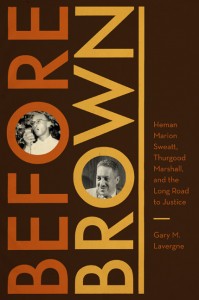 Published scholarship on black history in Texas is growing and we’d like to share with you some suggested readings, both current and past, from some of the preeminent history scholars in Texas and beyond. We invite you to take a look at our bookshelf page – including a featured selection – and check back as the list grows. A different selection will be featured each week. We welcome suggestions and reviews. This week, we offer, “Before Brown: Heman Marion Sweatt, Thurgood Marshall, and the Long Road to Justice,” by Gary M. Lavergne.
Published scholarship on black history in Texas is growing and we’d like to share with you some suggested readings, both current and past, from some of the preeminent history scholars in Texas and beyond. We invite you to take a look at our bookshelf page – including a featured selection – and check back as the list grows. A different selection will be featured each week. We welcome suggestions and reviews. This week, we offer, “Before Brown: Heman Marion Sweatt, Thurgood Marshall, and the Long Road to Justice,” by Gary M. Lavergne.
On February 26, 1946, an African American from Houston applied for admission to the University of Texas School of Law. Although he met all of the school’s academic qualifications, Heman Marion Sweatt was denied admission because he was black. He challenged the university’s decision in court, and the resulting case, Sweatt v. Painter, went to the U.S. Supreme Court, which ruled in Sweatt’s favor. The Sweatt case paved the way for the landmark Brown v. Board of Education of Topeka rulings that finally opened the doors to higher education for all African Americans and desegregated public education in the United States.
In this engrossing, well-researched book, Gary M. Lavergne tells the fascinating story of Heman Sweatt’s struggle for justice and how it became a milestone for the civil rights movement.
This Week in Texas Black History
Jun 4
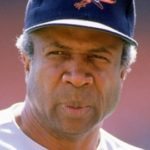 In 1991, on this day, Baltimore Orioles manager Frank Robinson is named assistant general manager of the club, only the third African American to become an assistant GM. As a player with the Orioles, Robinson, a Beaumont native, won the triple crown (leading the league in home runs (49), runs batted in (122), and batting average (.316) in 1966. Robinson began managing the Cleveland Indians in 1975 as the first African American to manage a major league team. He was elected to the Baseball Hall of Fame in 1982.
In 1991, on this day, Baltimore Orioles manager Frank Robinson is named assistant general manager of the club, only the third African American to become an assistant GM. As a player with the Orioles, Robinson, a Beaumont native, won the triple crown (leading the league in home runs (49), runs batted in (122), and batting average (.316) in 1966. Robinson began managing the Cleveland Indians in 1975 as the first African American to manage a major league team. He was elected to the Baseball Hall of Fame in 1982.
Jun 5
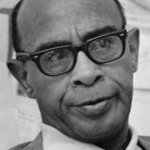 On this day in 1950, The U.S. Supreme Court ordered Heman Sweatt admitted to the University of Texas Law School. In handing down its decision in Sweatt v. Painter, the Court concluded that black law students were not offered substantial quality in educational opportunities and that Sweatt could therefore not receive an equal education in a separate law school. Sweatt had teamed with the NAACP to challenge the admissions policy at the UT Law School. The NAACP was looking to test separate but equal education statutes in Texas and the result of Sweatt’s legal battle struck down segregationist policies at the school (for graduate and professional programs only), gained him admission, and paved the way for the landmark decision of Brown v. Board of Education in 1954, which opened integration for undergraduates.
On this day in 1950, The U.S. Supreme Court ordered Heman Sweatt admitted to the University of Texas Law School. In handing down its decision in Sweatt v. Painter, the Court concluded that black law students were not offered substantial quality in educational opportunities and that Sweatt could therefore not receive an equal education in a separate law school. Sweatt had teamed with the NAACP to challenge the admissions policy at the UT Law School. The NAACP was looking to test separate but equal education statutes in Texas and the result of Sweatt’s legal battle struck down segregationist policies at the school (for graduate and professional programs only), gained him admission, and paved the way for the landmark decision of Brown v. Board of Education in 1954, which opened integration for undergraduates.
Jun 6
On this day in 1944, Olympic sprint champion Tommie Smith was born in Clarksville. The seventh of 12 children, he survived a life-threatening bout of pneumonia as an infant. Smith is the only man in the history of track and field to hold 11 world records simultaneously. At San Jose State University, he tied or broke 13 world records. However, he is most remembered as one half of the duo of black U.S. Olympians – along with John Carlos – who, during the 1968 Summer Games in Mexico City, stood on the victory stand with heads bowed and raised clinched fists in a demonstration for human rights, liberation and solidarity. The protest overshadowed Smith’s performance on the track where he broke the world and Olympic records, winning a gold medal in the 200-meter sprint with a time of 19.83 seconds. The story of the “silent gesture” is captured in the 1999 HBO-TV documentary, “Fists of Freedom.” In 1978, Smith was inducted into the National Track & Field Hall of Fame, and has accumulated many other honors.
Jun 7
On this day in 1950, John Chase enrolled in the University of Texas School of Architecture graduate program, becoming the first African-American to enroll at a major university in the South. Chase, a native of Annapolis, Md., earned a Master of Architecture degree in 1952 and became the first black graduate of the University. That same year, he also became the first licensed African-American architect in Texas and was the only black architect licensed in the state for almost a decade. In 1980, he became the first African-American appointed to the U.S Commission of Fine Arts. His firm’s designs include: the George R. Brown Convention Center in Houston, the Harris County Astrodome Renovation, and the Thurgood Marshall School of Law at Texas Southern University.
Jun 9
 On this date in 1965 the University Interscholastic League State Executive Committee validated the Legislative Council’s decision to open league membership to all public schools. The UIL was formed in 1913 with the stipulation that its membership was open only to white schools. In 1920, the Prairie View Interscholastic League was formed as the UIL’s counterpart to govern academic and athletic competitions for the state’s high schools for black students. Black schools began UIL competition in the 1967-68 school year. After the 1969-70 school year, the UIL fully absorbed all PVIL member schools. The PVIL played a leading role in developing African-American students in the arts, literature, athletics and music from the 1920’s through 1970. Among its football stars, alone, were: Bubba Smith(Beaumont Charlton-Pollard), “Mean” Joe Greene (Temple Dunbar), Otis Taylor (Houston Worthing), Ernie Ladd (Orange Wallace), and Jerry Levias (Beaumont Hebert).
On this date in 1965 the University Interscholastic League State Executive Committee validated the Legislative Council’s decision to open league membership to all public schools. The UIL was formed in 1913 with the stipulation that its membership was open only to white schools. In 1920, the Prairie View Interscholastic League was formed as the UIL’s counterpart to govern academic and athletic competitions for the state’s high schools for black students. Black schools began UIL competition in the 1967-68 school year. After the 1969-70 school year, the UIL fully absorbed all PVIL member schools. The PVIL played a leading role in developing African-American students in the arts, literature, athletics and music from the 1920’s through 1970. Among its football stars, alone, were: Bubba Smith(Beaumont Charlton-Pollard), “Mean” Joe Greene (Temple Dunbar), Otis Taylor (Houston Worthing), Ernie Ladd (Orange Wallace), and Jerry Levias (Beaumont Hebert).
Blog: Ron Goodwin, Ph.D., author, PVAMU history professor
Ron Goodwin is an assistant professor of history at Prairie View A&M University. Even though he was a military “brat,” he still considers San Antonio home. Like his father and brother, Ron joined the U.S. Air Force and while enlisted received his undergraduate degree from Texas Lutheran University in Seguin, Texas. After his honorable discharge, he completed graduate degrees from Texas Southern University. Goodwin’s book, Blacks in Houston, is a pictorial history of Houston’s black community. His most recent book, Remembering the Days of Sorrow, examines the institution of slavery in Texas from the perspective of the New Deal’s Slave Narratives.
Recent Posts
King of Kings
During his lifetime Martin Luther King consistently paralleled the experiences of the biblical Children of Israel and the experiences of Africans in America. As a result, he thrust himself into the role of Moses. What I find interesting in these parallels was the ultimate goal of the story. The Children of Israel, after 400 years of bondage, eventually made their way to the Promised Land. This was the message that I believe King was ultimately…
Wakanda Forever — Part 2
The internet records the following regarding the financial success of the Black Panther as of March 25, 2018: Receipts grossed $631.4 million in the US and Canada and a worldwide total of $1.239 billion; The film made $370.5 million worldwide in its opening weekend (the 15th largest of all time); Thus far, Black Panther is the highest-grossing solo superhero film and the 3rd third highest-grossing movie in the Marvel Cinematic Universe (MCU); and In only five weeks after…
Submissions wanted
Historians, scholars, students, lend us your…writings. Help us produce the most comprehensive documentation ever undertaken for the African American experience in Texas. We encourage you to contribute items about people, places, events, issues, politics/legislation, sports, entertainment, religion, etc., as general entries or essays. Our documentation is wide-ranging and diverse, and you may research and write about the subject of your interest or, to start, please consult our list of suggested biographical entries and see submission guidelines. However, all topics must be approved by TIPHC editors before beginning your research/writing.
We welcome your questions or comments. Please contact Mr. Michael Hurd, Director of TIPHC, at mdhurd@pvamu.edu.


